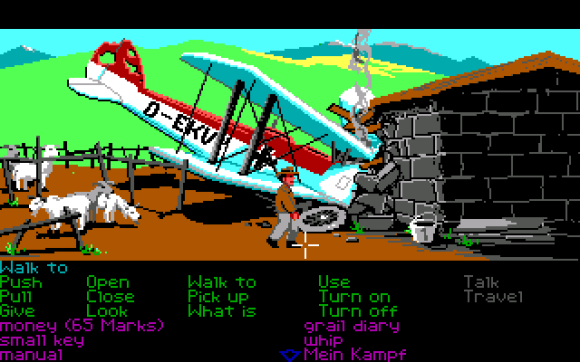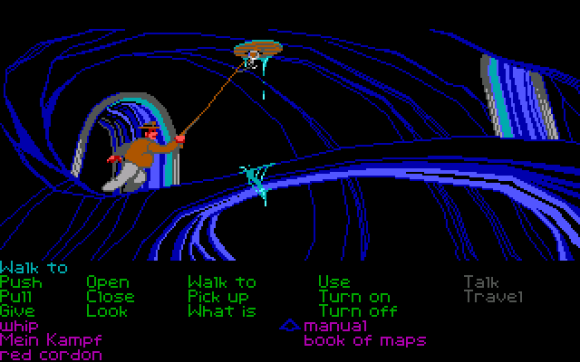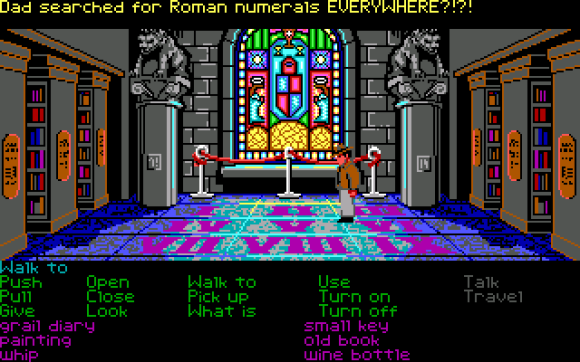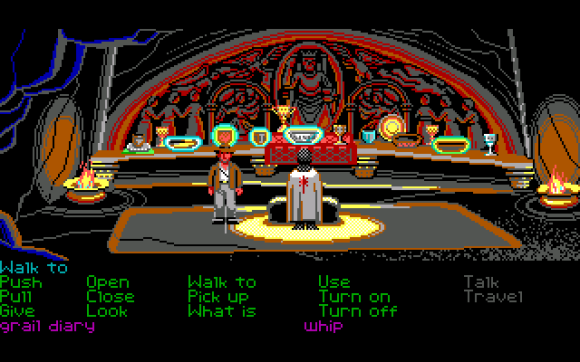Ah, now we’re getting somewhere.
After the sprawling, non-linear messes of Maniac Mansion and Zak McKracken And The Alien Mind-Benders, I find it a little ironic that it was the imposition of having to make a movie tie-in game that forced LucasArts to adopt the more traditional structured linear progression that we’ve come to recognise as their hallmark. Indiana Jones And The Last Crusade: The Graphic Adventure1 closely follows Indiana Jones’s search for the Holy Grail as portrayed in the film: Indy starts at the college where he is a professor of archaeology and finds out his father has disappeared while hunting for the Grail in Venice; flies to Venice to pick through the catacombs there to find clues as to the Grail’s location; then to Brunwald castle in Austria to find further Grail clues and rescue his father; and then finally to the Grail temple itself. Each major location in the game is a self-contained chapter, and that makes Last Crusade much easier to parse as a game because, much like later games such as Monkey Island, Indy explores a location, solves the puzzles there, and then moves on to the next one with no backtracking or repetition.
Even if it’s not entirely intentional on the part of the developers, this imposed structure is very welcome. Indiana Jones And The Last Crusade is the first LucasArts adventure game that actually feels like one, with semi-logical puzzles that you can get a leg up on if you’ve seen the film and only a few items that are used outside of the areas in which they are found. While the puzzle design still isn’t all there yet, the compartmentalisation of puzzles into distinct, non-overlapping areas means that the occasional flying leaps of logic required to solve them grate far less than they would do otherwise, as the solution space is far smaller and it is now much more feasible to attempt to brute force that solution via trial and error without wasting hours and hours of time. This is not a sign of good puzzle design, obviously, but it is a sign of a game with a decent structure; getting stuck in Last Crusade was nowhere near as annoying as it was in Maniac Mansion or Zak McKracken, as I could often figure out the answer in five minutes of randomly clicking on things.
The first thing you’ll notice about Last Crusade are the much-improved visuals compared to Zak McKracken. The Commodore 64 has been ditched and LucasArts are now developing for MS-DOS PCs (with Amiga and Atari ports), so the LucasArts artists can use the increased detail to let them do things like “perspective” and “characters with normal human proportions that don’t look like space aliens”. Even leaving aside the increased power available to them, though, there’s a palpable sense of fun about Last Crusade’s art and animations, with the opening credits being a pastiche of the train scene from the prologue of the film, a big CENSORED marker appearing whenever Indy changes clothes (and when he falls foul of one of the deathtraps at the end), and even a precursor to some of the many visual gags in Monkey Island when Indy pulls a clearly too-large metal post out of his jacket and looking around furtively before smashing it against the library floor. The artists are still stuck with the 16-colour EGA palette so they can’t get too fancy, but I noticed increased use of a technique called dithering, where two colours are alternated in a checkerboard pattern to create the perception of a third shade that’s in between the two, and which really lets the artists squeeze all they can out of those 16 colours. They don’t really get into dithering until Loom and Monkey Island and so Last Crusade still has big, solid, comparatively ugly blocks of colour making up most of its art, but something I’m noticing looking back over the screenshots is an increased use of lighting effects. It’s the fully-lit daytime areas where Last Crusade looks its worst, and the gloomy catacombs and castle dungeons where it looks its best, and I think that’s because of how the lighting is drawn in these dimly-lit scenes.
(That and EGA having a very good pair of blue colours that work well with black to create these darkness effects. You can tell the artists like them the most, which is why the first chapter of Monkey Island arguably goes a little overboard with them.)
The second thing you’ll notice about Last Crusade are two crucial additions to the verb list.
Yes, WHAT IS is, unfortunately, still here. However, READ has been replaced by the much more useful (in theory) LOOK, and a TALK verb has also been added! Thanks to the sort of game Last Crusade is it unfortunately doesn’t get much of a workout, as while it has LucasArts’ first ever conversation system it prefers to use it as an additional kind of puzzle where you try and fool a series of Nazi guards into letting you pass rather than as a means of conveying information. One thing that Last Crusade does understand very well is that, even though it is an adventure game, it wouldn’t be an Indiana Jones adventure game if you couldn’t punch any Nazis, which is why it adds the Renegade option of “Throw Punch” to every single conversation you have with a Nazi; this throws you into Last Crusade’s boxing minigame, which is an almost direct lift of the fencing mechanics from Pirates! and which works pretty well because of this. However, punching is a last resort after failing the conversation puzzle, where you have to figure out which responses are most appropriate from the way the guard is talking to you; pick the right ones and he’ll let you go and won’t bother you any more, pick the wrong ones and he’ll aggro and you’ll have to fight him. Unfortunately this is a very hit-and-miss affair; sometimes you’ll get it easily, and sometimes you’ll end up having to savescum your way through it if you want to avoid a punchup. Outside of the guard conversations there’s maybe two actual conversations in the game, one of which is used for copy protection and both of which are incredibly short (although there is much more incidental dialogue — and useful incidental dialogue — than there was in either Zak McKracken or Maniac Mansion). Still, it’s here in a basic form, and it’s the start of something amazing.
Unfortunately despite these new and welcome additions that move Last Crusade closer to the modern mean of adventure games, it’s still got some unusual and not particularly good stuff in it. First is that Zak McKracken’s love of mazes makes it over to Last Crusade too. Last Crusade’s versions are actual top-down mazes, at least, which are much easier to find your way around than the abstract disconnected screens of Zak, but it gets a bit old when, after dealing with the maze that is the Venice catacombs, and the maze that is Brunwald castle, you then have to deal with another maze when escaping the zeppelin on your way to the Grail temple. The catacombs are empty and are just pure puzzle, but the castle and zeppelin mazes are patrolled by Nazi guards; the guards in Brunwald can be talked out of a fight, but the zeppelin guards lock you into a boxing contest if you can’t avoid them. And while the boxing minigame is fine in moderation, it’s not the sort of thing you can base an entire section of the game on top of.
Also dragging it down is the fact that LucasArts still have not figured out how to do puzzle design. I said it was more logical and structured than Maniac Mansion or Zak McKracken, and it is, but that doesn’t mean the puzzle design approaches anywhere near as good as Monkey Island. This is partly down to the LOOK verb not being all there yet — you can use it on more things now, but on most objects it still yields a generic “I don’t see anything special about that”, even critical puzzle and plot items – but there’s also several points in the game where you need to go pixel hunting. A good example is at the start, when you visit Sean Connery’s ransacked house; you can pull down one of the bookcases, so it stands to reason there must be something behind it, but I couldn’t see anything obvious and after waving WHAT IS around for a couple of minutes I couldn’t find anything. I checked a walkthrough and it said there was a “sticky tape” item behind there, which is what I was expecting to find, so I resumed combing the back of the bookcase with WHAT IS and eventually found it.
See the single pixel of brown there in the middle of my mouse cursor? That’s the sticky tape. Unbelievable2.
This finicky tendency gets even worse towards the end of the game, when you’re doing the three trials in the Grail temple. Two of the three trials require you to click on a specific pixel on the screen to not die, and this time you’re not even given any clues via WHAT IS. You just have to figure out which pixel is the correct one via trial and error, which is a staggeringly obnoxious thing to do when the game locks off saves while you’re inside the temple; if you die at any point you get booted back to the start of the temple and have to do all of the trials again. Fortunately ScummVM has no such restrictions (its saves are more like emulator save states and allow you to save and resume even in areas where you weren’t able to in the original game), and so I was spared the indignity of having to replay the same five minutes of the game over and over again, but even when I read a description of where exactly I was supposed to be clicking I couldn’t get it right. Hell, I eventually resorted to watching a longplay of the game on Youtube and clicking in the same spot as the player did there — and even then it took three goes to get it right. How the hell anyone had patience for this back in 1989 is completely beyond me.
The thing is, for players who are willing to go the extra mile and pixel-hunt on every screen, Last Crusade actually has some pretty cool stuff in it. Pixel hunting the sticky tape from the back of the bookcase allowed me to pick up a replica Grail Diary that I handed over to the Nazis in place of the real one, which let me skip a whole section of gameplay where Indy goes to Berlin to get it back. Pixel hunting in the library will reveal two optional books that you can pick up; one is a map of the catacombs you’re about to jump into, which is quite handy, and the other is a set of instructions for how to start a biplane. Take this with you through the rest of Venice and Brunwald castle and you can use it to steal a biplane from the aerodrome, skipping the zeppelin segment entirely. Once you’re in the biplane you get a little minigame where you try to evade and shoot down pursuing fighters; eventually you’re shot down yourself and have to continue past Nazi roadblocks in a car, sweet-talking, bribing or punching each roadblock guard as appropriate. However, if you do particularly well in the biplane section you’ll fly over more of these roadblocks and will have fewer to deal with when your plane inevitably gives up the ghost. And if you do go to Berlin, and picked up the right item from Brunwald castle, you can come away with a signed travel pass that lets you straight up bypass all of the roadblocks.
The thing Last Crusade did that I liked the most, though, is something that you don’t see any more in videogames since they did away with the big boxes full of feelies. The original physical release of Last Crusade came with several feelies, including a 70-page version of the Grail Diary. On your way through the game you’ll pick up several clues as to what the Grail looks like; these appear innocuous at the time (and one of them is quite easy to miss, which I did not like), but end up being critically important at the very end of the game once you’ve made it through all three trials and into the chamber where the Grail is kept, because you’ll be presented with this screen:
Ten Grails to choose from! The correct grail is chosen randomly when you start the game, so you can’t rely on a walkthrough to tell you which one it is — and picking the wrong one has the same effect as in the film, and boots you all the way back to the start of the temple to do those wonderful pixel-hunting puzzles again. In order to pick the right one you need to cross-reference the Grail clues you’ve picked up with your physical Grail Diary (or in my case, the PDF of it that GOG have helpfully provided) to figure out what the real Grail looks like. I like games that make me do something real and tangible outside of the standard game mechanics, and Last Crusade’s implementation ties in very well to the idea of being an adventurer archaeologist on a hunt for ancient artifacts.
That’s something that Last Crusade does well in general, and which made me forgive its many, many flaws. It feels like an Indiana Jones game, with much more use of music that has been ripped straight from the film; sure, it’s a tinny 1989 computer version, but it’s still very recognisably the same stuff. Whenever you move between locations you get the classic Indiana Jones red-line-moving-across-map globetrotting sequences. Indy uses his whip on several occasions, and there’s a lot of bespoke Indy animation in the game when he’s solving puzzles that imbue him with a lot of Indy character. Even the bit in Brunwald castle, which is a bit painful thanks to the mazes and the guards, has you disguising yourself in a variety of uniforms to fool Nazis, and Indy does that all the time in the films. In mechanical terms Last Crusade might be rather scattershot with its various ideas — I don’t think LucasArts ever made another game with mazes and boxing and a biplane minigame and a physical Grail Diary that was crucial to completing the game — but the Indiana Jones theme and the linear movie structure does a lot to help it all make sense. Its implementation of LOOK and TALK might be underwhelming but the fact that they’re present at all is an important development for future LucasArts titles, and the subtle visual humour in the game presages the heights they’d later hit with Monkey Island. On its own, Last Crusade might not be a good adventure game (although I would argue that it is at least acceptable), but in the context of the wider LucasArts oeuvre it’s an important stepping stone to much greater things.
- Subtitle required to distinguish it from the incredibly bad Indiana Jones And The Last Crusade: The Action Game. ↩
- I actually booted up the VGA version to see if it was any more obvious, as that was the version I played 25 years ago and I didn’t remember having this much trouble with it. There, the sticky tape is an overwhelmingly generous three pixels instead of one. ↩





I remember being 12 and howling of frustration at the Grail Temple section. Thanks for the ride down memory lane. It may not be a great adventure game but certainly it was a *memorable* game!